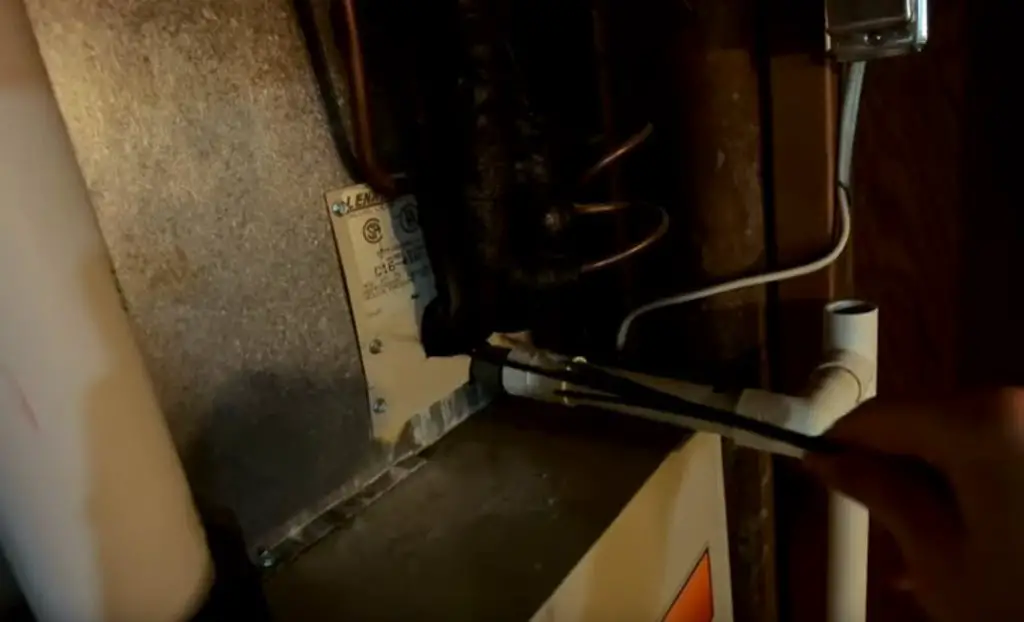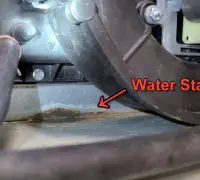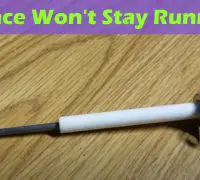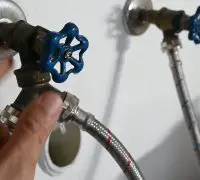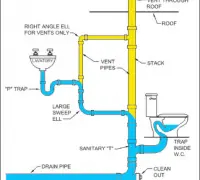If you notice any puddle near your furnace, you will most likely want to fix it. It’s also essential that you find the cause of your leaking furnace. Or is it your AC that is leaking?
Briefly, water leaking from the furnace when AC is on happens because the HVAC condensate drain line has cracks or blockage. A dirty air filter or insufficient refrigerant can also cause it. The fixes are effortless, such as cleaning the condensate drain line, adding refrigerant, and cleaning or replacing the filter.
Identifying the AC-related furnace leak can be trickier than you think, so we encourage you to keep reading. You will understand why your furnace might leak when the AC is on and you will learn how to fix it.
Page Table of Contents
Your Furnace and AC might be connected when running. But how?
The furnace and AC are components of your HVAC (Heating, ventilation, and Air conditioning) system. The system counts for the air and temperature comfort inside your house. Since the elements of the HVAC system are connected, they depend on each other for the best performance. Therefore, understanding how the system works will help you know why the furnace leaks when the AC runs. Furthermore, you will discover if troubleshooting is enough or if you need to contact your HVAC technician.
The furnace and AC are connected on many levels:
- The furnace and AC use the same condensate drain line to send out the moisture from the cooling and heating processes
- The appliances use the same ductwork that sends cool air from the AC in the summer and warm air from the furnace during the cold winter months
- The thermostat controls both the AC and the furnace. Heating turns the furnace on, whereas cooling turns the AC on. If the setting is wrong, the heating and air conditioning processes will perform inadequately.
- Air filters in the HVAC system work with the furnace and AC unit. They will send air through the filter to remove dust and debris. A clogged filter will worsen the air quality.
- The AC doesn’t use the furnace’s humidifier as the AC is supposed to dehumidify the air. However, if the furnace’s humidifier stays On in the summer, it will alter the dehumidification process.
Now that you see how the furnace and AC are connected, you might understand how your furnace might leak (or seem to leak) when the AC operates.
Why does your furnace leak when the AC is on?
Even if many issues may cause the furnace’s leak when the AC is on, the most common problems come from the condensate drain system. The most common causes come next:
Cracked or clogged condensate drain
The home’s heating and cooling typically generate water as a byproduct. When cooling air, the AC system will draw moisture from the air through a cooling process.
When the AC doesn’t perform correctly, water will go into the condensate pan and down the drain outside the house. A blocked condensate drain(due to dirt and dust) will make the water overflow from the AC and get under the furnace. You will falsely believe that the furnace is leaking.
A crack in the condensate drain line generates a leak that may get under and around the furnace, making you think that the furnace is leaking.
The condensate pan is cracked
The metal condensate pan can get old, rust, and fill holes after many years of use. The plastic condensate pan is less durable than the metal one. The cracks and gaps can leak the pan and send water to the furnace.
A cracked condensate pan has an easy fix—you only need to replace the pan or repair the cracking with a sealant (if it’s a plastic pan). Don’t postpone fixing it, as leaking water threatens the home flooring and HVAC system.
The condensate pump of the AC is broken
The HVAC system presents a condensate pump when the AC and furnace are installed in the basement. The pump pushes the collected water up the drain and directs it out of your house. If the condensate drain is blocked, the malfunctioning condensate pump will let condensate water from the AC collect in the pump tank. When the tank is full, the water will overflow and stagnate in the condensate pan and draining pipe. You will soon notice a leak underneath the furnace.
The air filter is filthy
The air filter in the HVAC system is for the heating and cooling unit to ensure good airflow. If the air filter is dirty, it won’t be able to filter the air that travels through the system and limit the flow of power to the evaporator coil,
An evaporator coil that doesn’t get enough airflow, combined with a compromised power flow because of a dirty filter, will decrease the temperature and freeze the evaporator coil. A frozen evaporator coil will easily suffer damage or even damage other elements of the unit. The melting ice will increase the water released through the condensate drain.
If the system doesn’t drain the water as it’s supposed, the extra water will get on the furnace and you’ll think that the leak comes from the furnace.
Not enough refrigerant for the AC
Refrigerant is a gas compound or a fluid in the AC systems. It absorbs heat from the environment and cools the air with compressors and evaporators. The refrigerant line in the AC is a closed loop; if it leaks, the refrigerant will look. The AC will no longer have enough refrigerant and you might notice the following:
- Warm air coming from the vents
- Low airflow
- Gurgling or bubbling noise from the AC system
- High electricity bill as the AC system works harder than before to cool down the air
- Refrigerant intoxication. The common symptoms are nausea, dizziness, and shortness of breath.
If the cooling process is compromised, the temperatures in the AC systems get lower than usual and cause the freezing of the evaporator coil. The collected moisture will no longer vaporize if the evaporator coil is frozen. When the temperatures go up again, the frozen moisture will melt and generate water around the furnace.
Malfunctioning evaporator coil
The evaporator coil includes several pipes above the HVAC system. If the airflow is poor, the evaporator coil will go wrong simply because the furnace’s filter doesn’t perform correctly. Therefore, the evaporator coil will no longer take the heat outside the house to reduce the temperature and send it back as cool air through the ducts inside the house. The process also counts for dehumidifying the air.
When the drain and condensate pan is clogged, or the pan has holes, the condensate dripping from the evaporator coil will get to the furnace, blower, and floor. When the evaporator coil isn’t properly functioning, excess moisture will develop and not get drained as it’s collected. A leak in the furnace will appear.
The temperatures outside are low and you run the AC
Cooling air systems are supposed to run when the air outside the house is warm. The evaporator coil might freeze if the AC operates even after the temperatures have decreased. The frozen moisture will melt and reaches the furnace when the temperatures increase. If the temperatures outside are below 60F degrees, you shouldn’t run the AC.
It’s tricky to say which of the issues above makes the AC cause an apparent leak in your furnace. Should you have the patience, skills, and equipment to assess the HVAC system, you can decide if you should fix the issue or contact an HVAC technician.
Here are the steps to follow to troubleshoot and manage the furnace leaking water when you turn on the AC:
Turn off the AC and remove water from the leak
It would help if you never tried to fix an electrical appliance when the power is on. Since the problems could alter the HVAC system, you should turn off the switch that takes power from the circuit breaker and gives it to the system.
Dry all the floor and any wet surfaces as well. The floors could experience permanent damage if water seeps in.
Check out the drain line—are there any cracks or blockages?
A clogged condensate drain line is a common leak in the HVAC system. However, it has an easy fix. Start by looking for a blockage attached to the drain pan at the draining house. Remove the dirt that blocks the waterway. If you can no longer see leaks, you’ve solved the problem.
Otherwise, you need to examine the pipe sending water outside the house. See if dirt or debris is blocking the pipe and use a fine wire or plumber’s snake to remove all dirt inside the pipe. Use some hot water and kitchen soap or vinegar to rinse the pipe. It will remove all leftover dirt in the drain line.
Take a look at the condensate drain line and see if there are any cracks, holes, or broken joints. If the leak doesn’t disappear after you’ve cleaned the drain, there might be another cause for the water leakage.
Is the condensate pump running?
When the HVAC condensate drain is clear and leaks still occur, you must check out the condensate pump. Check out the power button and circuit breaker. Pour water into the pump tank and run the pump. You should clean the hose if the pump runs but the water doesn’t go up the drain hose. Should you not get results, a pump motor failure or a microswitch could be the cause. If so, you need to hire an HVAC technician to confirm the damage.
When you have to replace the condensate pump, look for a high-efficiency model that pumps a good deal of water per hour and comes with a safety switch.
Take a look at the air filter
The air filter in the HVAC system needs checking once a month as it has to be clean and functional. If the air filter is dirty and only three months old, you can easily clean it and put it back. However, you should replace it if it’s older than 3 months and gets dirty quickly.
Replacing or cleaning the air filter is an excellent solution for many issues with condensate oil. A dirty filter that doesn’t send enough air to the coil can make an evaporator coil freeze. Ideally, cleaning the filter should eliminate the furnace water leakage issues. If not, it’s time to contact an HVAC technician.
Call the HVAC technician to fix a refrigerant leak
If none of the previous fixes reveals the cause of the leak, you need to examine the refrigerant leak. However, this is a problem that it’s better left to the professionals. It’s not a problem to asses or solves on your own, as exposure to refrigerant chemicals is dangerous.
There’s something else you need to check out. Ensure you’re not running the AC when outside temperatures are too low (below 60F degrees).
Before you go away
The HVAC is a system that includes several components. It makes perfect sense that the parts affect each other, so issues in the AC will also impact the furnace. When your furnace appears as if it’s leaking, the AC might not be able to remove the water from the cooling process as it should. There are many causes to troubleshoot on your own, but some should be left to an HVAC technician.
